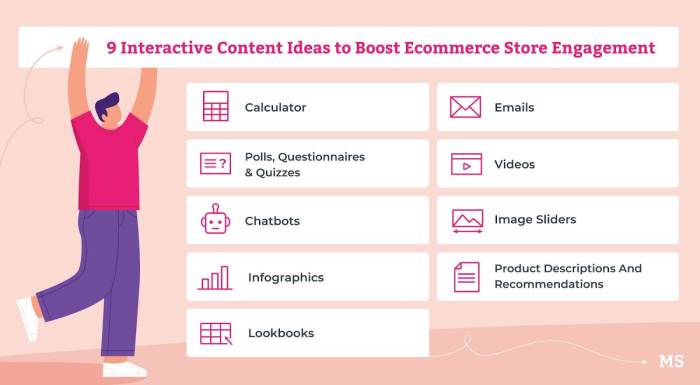Using Interactive Content in Marketing sets the stage for this enthralling narrative, offering readers a glimpse into a story that is rich in detail with american high school hip style and brimming with originality from the outset.
Interactive content is not just a trend; it’s a powerful tool that can revolutionize marketing efforts and drive real results. From captivating quizzes to interactive calculators, this innovative approach keeps audiences engaged and eager for more. Get ready to dive into the world of interactive content and discover how it can transform your marketing game!
Importance of Interactive Content in Marketing
Interactive content is not just a trend but a necessity in modern marketing strategies. It allows brands to engage with their audience in a more personalized and immersive way, creating memorable experiences that drive brand awareness and loyalty. By actively involving consumers in the marketing process, interactive content can significantly increase engagement and conversions.
Examples of Successful Interactive Content Campaigns
- Coca-Cola’s “Share a Coke” campaign, where customers could personalize Coke bottles with their names, leading to a huge social media buzz and increased sales.
- BuzzFeed’s interactive quizzes and polls that not only entertain but also provide valuable insights into their audience’s preferences and behaviors.
- Taco Bell’s Snapchat scavenger hunt, where followers had to solve clues to find hidden items and unlock exclusive deals, driving both online and in-store traffic.
How Interactive Content Increases Engagement and Conversions
- Interactive content encourages active participation from consumers, making them more likely to spend time engaging with the brand.
- By providing personalized experiences, interactive content can create a stronger emotional connection with the audience, leading to increased brand loyalty.
- Interactive content often collects valuable data and insights about consumer preferences and behaviors, allowing brands to tailor their marketing efforts more effectively.
Types of Interactive Content
Interactive content comes in various forms and can be utilized in marketing strategies to engage with the audience in unique and impactful ways.
Quizzes
Quizzes are a popular form of interactive content that allows brands to test their audience’s knowledge, personality traits, or preferences. By offering a fun and interactive experience, quizzes can drive engagement and capture valuable data about the audience.
Polls, Using Interactive Content in Marketing
Polls are another effective type of interactive content that enables brands to gather feedback from their audience in real-time. By asking simple questions and allowing users to vote, brands can gain insights into customer preferences and opinions.
Calculators
Calculators are a practical form of interactive content that can provide value to the audience by helping them make informed decisions. Whether it’s a mortgage calculator, savings calculator, or calorie calculator, this type of content can keep users engaged while offering a useful tool.
Interactive Infographics
Interactive infographics combine visual storytelling with interactive elements to provide a dynamic and engaging experience for the audience. By allowing users to explore data points, animations, or clickable elements, brands can convey complex information in a digestible and entertaining way.
Augmented Reality (AR) Experiences
AR experiences take interactive content to the next level by blending the virtual world with the real world. Brands can use AR to create immersive and interactive experiences that allow users to engage with products or services in a unique and memorable way.
Interactive Videos
Interactive videos enable brands to create engaging and personalized experiences for their audience. Whether it’s adding clickable hotspots, interactive quizzes, or choose-your-own-adventure scenarios, this type of content can increase viewer engagement and drive conversions.
Benefits of Using Interactive Content

Interactive content offers numerous advantages for businesses looking to enhance their marketing strategies. By incorporating interactive elements into their campaigns, companies can engage their audience in a more dynamic and personalized way, leading to increased brand visibility and customer loyalty.
Improved Brand Visibility and Customer Relationships
- Interactive content allows brands to stand out in a crowded digital landscape by offering unique and engaging experiences to their target audience.
- By providing interactive quizzes, polls, or calculators, businesses can capture users’ attention and encourage them to spend more time interacting with their brand.
- Through interactive content, companies can build stronger relationships with their customers by creating memorable and interactive experiences that resonate with their audience.
- By fostering a sense of community and interactivity, brands can increase customer engagement and loyalty, leading to higher retention rates and repeat business.
Valuable Data Insights for Marketing Strategies
- Interactive content allows businesses to collect valuable data insights about their audience’s preferences, behaviors, and interests.
- By analyzing user interactions with interactive elements, companies can gain a deeper understanding of their target market and tailor their marketing strategies accordingly.
- Through interactive content, businesses can track user engagement metrics such as click-through rates, time spent on page, and completion rates, providing valuable feedback for optimizing future campaigns.
- By leveraging data insights from interactive content, companies can create more targeted and personalized marketing campaigns that resonate with their audience and drive better results.
Best Practices for Implementing Interactive Content: Using Interactive Content In Marketing

Interactive content is a powerful tool in marketing, but to truly make an impact, it’s essential to follow best practices. By creating content that resonates with your target audience and optimizing it for different platforms, you can boost engagement and drive results.
Key Steps for Creating Interactive Content
- Understand Your Audience: Before creating interactive content, research and analyze your target audience to tailor the content to their preferences and interests.
- Set Clear Goals: Define specific goals for your interactive content, whether it’s increasing brand awareness, generating leads, or driving sales.
- Create Compelling Content: Develop interactive content that is visually appealing, engaging, and provides value to your audience.
- Choose the Right Tools: Select the appropriate tools and platforms for creating interactive content based on your goals and target audience.
- Promote Your Content: Use multiple channels to promote your interactive content, including social media, email marketing, and paid advertising.
Tips for Designing Interactive Content for Different Platforms
- Website: Ensure your interactive content is mobile-responsive, easy to navigate, and integrates seamlessly with your website design.
- Social Media: Tailor your interactive content for each social media platform, leveraging features like polls, quizzes, and live videos to engage your audience.
- Email: Personalize your interactive content for email campaigns, using interactive elements like surveys or interactive infographics to increase click-through rates.
Importance of Testing and Optimizing Interactive Content
Creating interactive content is just the first step. It’s crucial to test and optimize your content continuously to improve performance and achieve your marketing goals. By analyzing metrics, gathering feedback, and making data-driven decisions, you can refine your interactive content to maximize engagement and conversions.





